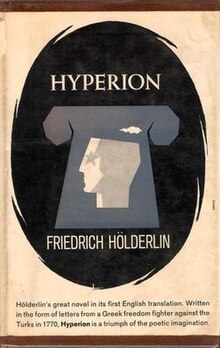Hyperion (Hölderlin)

First English Edition Cover
|
|
| Author | Friedrich Hölderlin |
|---|---|
| Original title | Hyperion oder Der Eremit in Griechenland |
| Translator | William Trask |
| Country | Germany |
| Language | German |
| Genre | Epistolary novel |
| Publisher | Friedrich Schiller (magazine serial) |
|
Publication date
|
1797 (volume one), 1799 (volume two) |
|
Published in English
|
1965 |
| Media type | |
| Pages | 169 |
Hyperion is an epistolary novel by the German Romantic Friedrich Hölderlin, first published in 1797 (Volume 1) and 1799 (Volume 2). The full title is Hyperion oder Der Eremit in Griechenland (Hyperion or The Hermit in Greece). Each volume is divided into two books, each second book including an epigraph from Sophocles.
The work is composed of letters from Hyperion to his friend Bellarmin, alongside a few letters between Hyperion and his love Diotima in the second volume of the novel. It is set in Greece and deals with invisible forces, conflicts, beauty, and hope. The novel begins right after Hyperion has already returned to Greece. The novel details the life of young Greeks fighting to gain Greek independence. In one of the footnotes Hölderlin specifically ties events in the novel with the Russians "bringing a fleet into the Archipelago" in 1770, likely framing the novel's events into the Orlov Revolt.
Both Bellarmin and Diotima would appear in Hölderlin's later poetry.
The work contains the interpolated poem "Hyperions Schicksalslied" (Hyperion's Song of Fate) on which Johannes Brahms composed the Schicksalslied Op.54 between 1869 and 1871.
Italian composer Luigi Nono includes passages from this work in his work Fragmente-Stille, an Diotima for string quartet (1980), as part of the score to be "sung" silently by the performers while playing the piece.
In 1983 the German sculptor Angela Laich created a sculpture she called Hyperion after the main character of the Hölderlin novel.
...
Wikipedia
